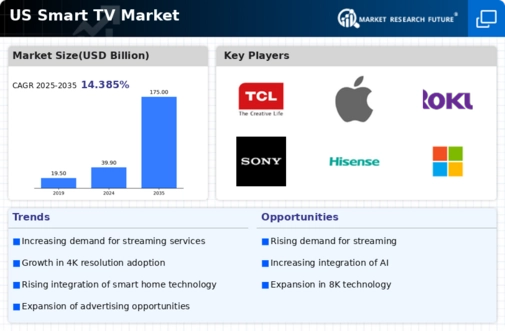The US Smart TV Market is characterized by intense competition among a variety of established and emerging brands, each vying to capture consumer attention through innovative features, competitive pricing, and enhanced viewing experiences. This market has evolved significantly over the past few years, driven by advancements in technology, changes in consumer preferences, and the increasing demand for connectivity and smart features in televisions. As Smart TVs become a central hub for home entertainment, companies are focusing on integrating various streaming services, improved interfaces, and compatibility with other smart home devices.
The competitive landscape is also influenced by factors such as marketing strategies, distribution channels, and partnerships with content providers, which further shapes the consumer experience in the US market.TCL has made a remarkable impact in the US Smart TV Market, positioning itself as a formidable contender through its value-driven offerings and advanced technology integration. Its ability to provide high-quality displays at competitive price points has resonated well with budget-conscious consumers, while its partnership with mainstream streaming services enhances the overall user experience.
The brand's strengths lie in its commitment to innovation, showcasing cutting-edge features such as 4K resolution, HDR support, and a user-friendly operating system that appeals to a broad audience. Additionally, TCL's strategic marketing efforts and strong distribution channels, particularly in big-box retailers and e-commerce platforms, have bolstered its presence in the US market, allowing it to expand its share while delivering an appealing combination of performance and affordability. Apple, with its distinct approach, has firmly established itself in the US Smart TV Market through its Apple TV product line, which offers an integrated ecosystem linking various Apple services and devices.
This seamless integration is a significant strength, as it provides users with easy access to popular streaming platforms and exclusive content options. Apple's emphasis on quality and user privacy has garnered a loyal customer base, and its ongoing efforts to enhance the Apple TV experience through regular software updates and feature improvements further strengthen its market positioning. Additionally, Apple's strategic acquisitions in the entertainment sector have expanded its market reach and enriched its content offerings.
Its investment in original programming and partnerships with prominent content providers reflect a commitment to delivering premium content, which resonates particularly well with its existing customer demographics in the US. Overall, Apple continues to carve out a niche in the smart TV space by leveraging its diverse product ecosystem and commitment to user experience.





















Leave a Comment